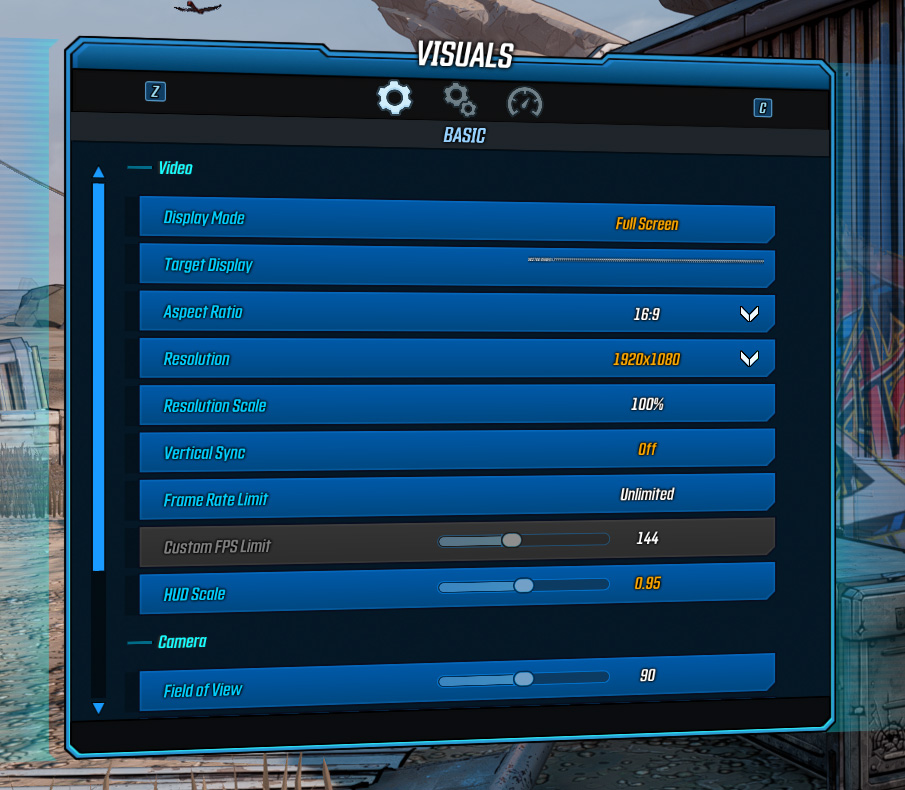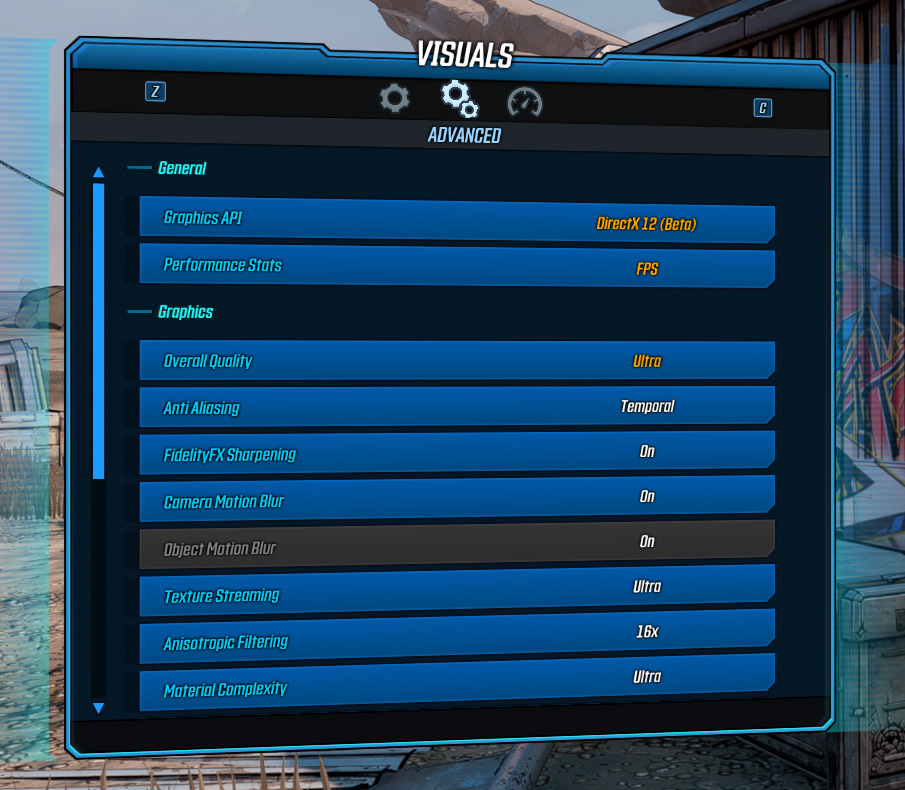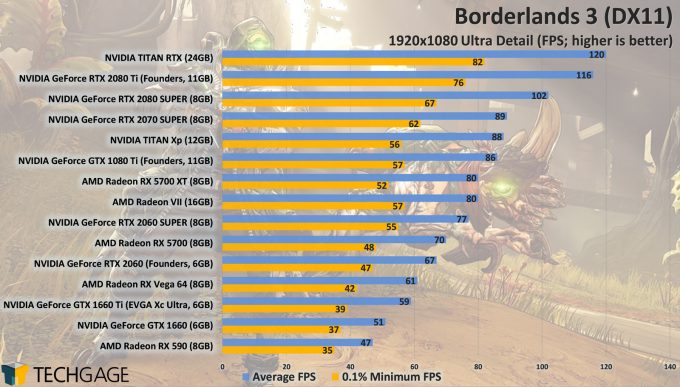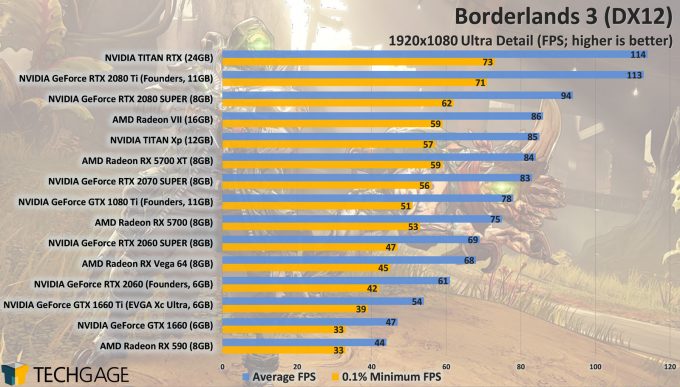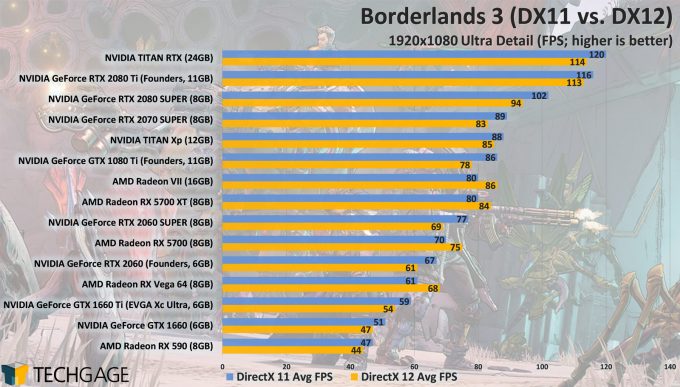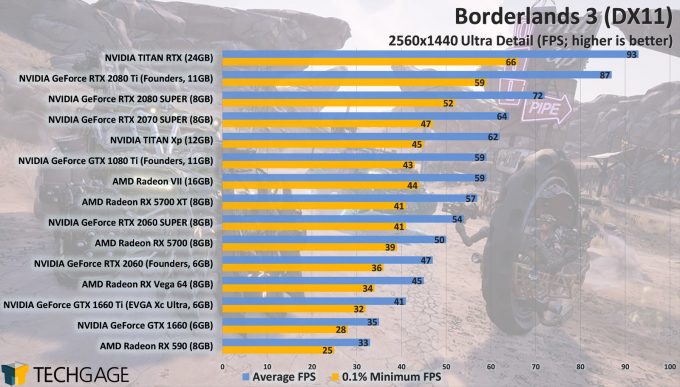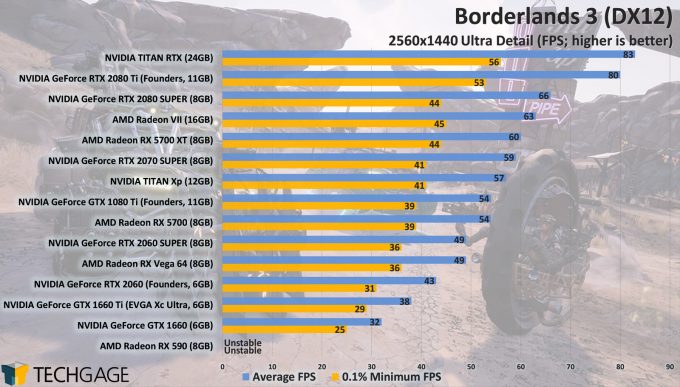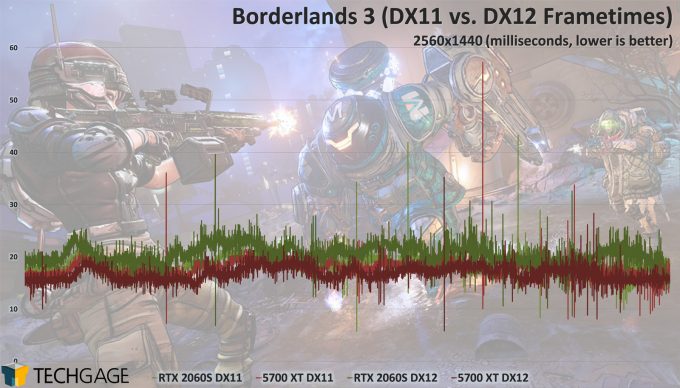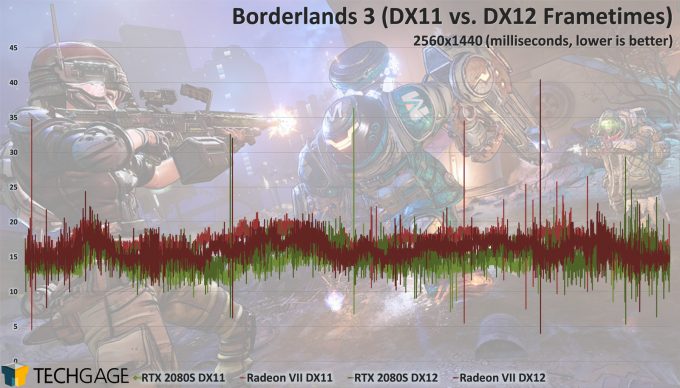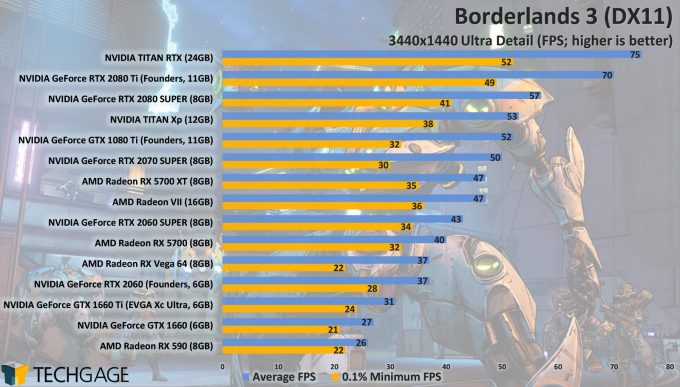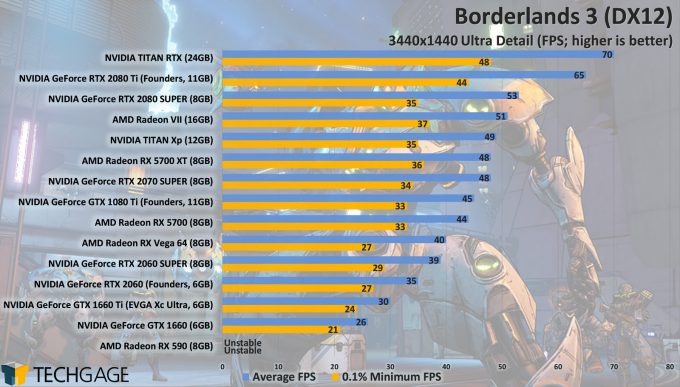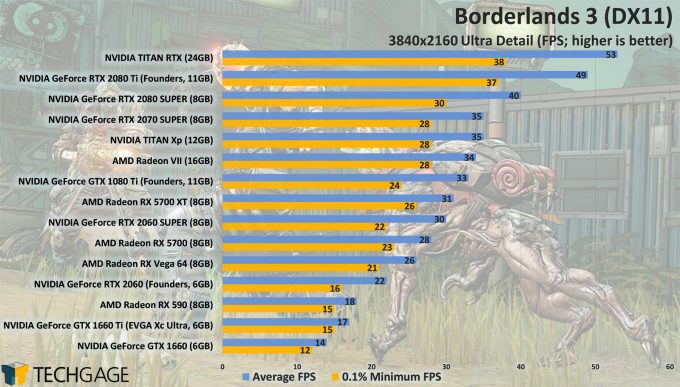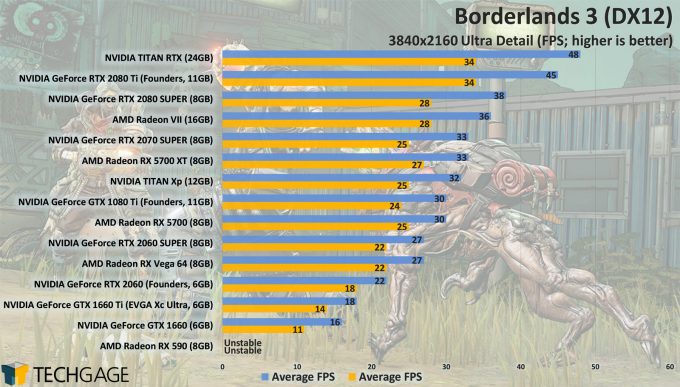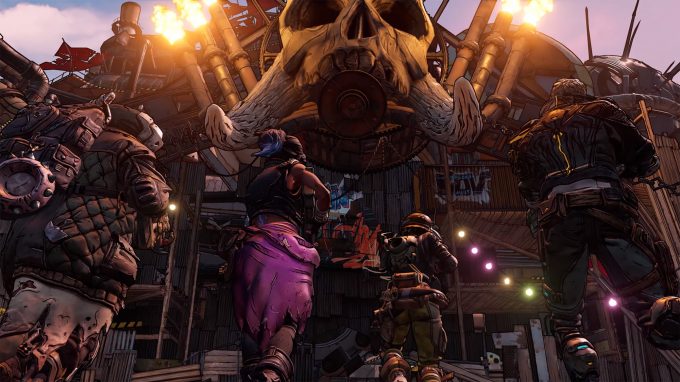- Qualcomm Launches Snapdragon 4 Gen 2 Mobile Platform
- AMD Launches Ryzen PRO 7000 Series Mobile & Desktop Platform
- Intel Launches Sleek Single-Slot Arc Pro A60 Workstation Graphics Card
- NVIDIA Announces Latest Ada Lovelace Additions: GeForce RTX 4060 Ti & RTX 4060
- Maxon Redshift With AMD Radeon GPU Rendering Support Now Available
Borderlands 3 1080p, 1440p, 4K & Ultrawide Benchmarks – DX11 vs DX12

Borderlands is back, and that means one thing: Borderlands benchmarking is also back! We’re taking a look at graphics card performance with the help of fifteen GPUs and four resolutions. Since the performance picture between AMD and NVIDIA varies quite a bit between DX12 and DX11, we’re including results for both.
Gearbox’s much-anticipated Borderlands 3 launched last Friday, and without wasting much time, we jumped in and took full advantage of… its built-in benchmark. Unfortunately, performance is a little spotty right now, something that forced us to run the test many more times than anticipated (350, but who’s counting?).
If you look at Borderlands 3 threads around the web, you’ll see a mix of complete glee that a new game has finally arrived mixed with absolute disdain at how a game could be released as buggy as it is. It seems like not everyone is dealing with the same issue; you might be bumping heads with one, while a friend will deal with another.
We don’t have much to comment on at this point, since we’ve only benchmarked the game. We can say that if you are having problems, you’ll want to make sure you are running an ideal API. Currently, that’d be DX11 for NVIDIA, and DX12 for AMD. We’ll talk more about this later.
Because Borderlands 3 has a built-in benchmark, we took the easy route and used it (since it’s actually worthwhile). Here’s the test PC used for all benchmarking:
| Techgage Gaming GPU Test PC | |
| Processor | Intel Core i9-9900K (3.6GHz Base, 5.0GHz Turbo, 8C/16T) |
| Motherboard | ASUS ROG STRIX Z390-E GAMING CPU tested with BIOS 1105 (June 6, 2019) |
| Memory | G.SKILL Flare X (F4-3200C14-8GFX) 8GB x 4 Operates at DDR4-3200 14-14-14 (1.35V) |
| AMD Graphics | AMD Radeon VII (16GB; Radeon 19.9.2) AMD Radeon RX 5700 XT (8GB; Radeon 19.9.2) AMD Radeon RX 5700 (8GB; Radeon 19.9.2) AMD Radeon RX Vega 64 (8GB; Radeon 19.9.2) AMD Radeon RX 590 (8GB; Radeon 19.9.2) |
| NVIDIA Graphics | NVIDIA TITAN RTX (24GB; GeForce 436.30) NVIDIA TITAN Xp (12GB; GeForce 436.30) NVIDIA GeForce RTX 2080 Ti (11GB; GeForce 436.30) NVIDIA GeForce RTX 2080 SUPER (8GB; GeForce 436.30) NVIDIA GeForce RTX 2070 SUPER (8GB; GeForce 436.30) NVIDIA GeForce RTX 2060 SUPER (8GB; GeForce 436.30) NVIDIA GeForce RTX 2060 (6GB; GeForce 436.30) NVIDIA GeForce GTX 1080 Ti (11GB; GeForce 436.30) NVIDIA GeForce GTX 1660 Ti (6GB; GeForce 436.30) NVIDIA GeForce GTX 1660 (6GB; GeForce 436.30) |
| Storage | Kingston SSDNow V310 960GB (SATA, Radeon install) WD Blue 3D NAND 1TB (SATA, GeForce install) |
| Power Supply | Corsair RM650x (650W) |
| Chassis | NZXT S340 Elite Mid-tower |
| Cooling | Corsair Hydro H100i V2 AIO Liquid Cooler (240mm) |
| Et cetera | Windows 10 Pro (64-bit; build 1903/18362) |
| All product links in this table are affiliated, and support the website. | |
Note: The drivers used for NVIDIA and AMD were the latest at time of publication, and included optimizations for Borderlands 3 at launch.
As with previous Borderlands titles on PC, there are a bunch of graphics settings that can be tweaked if the game’s performance is leaving a bit to be desired. The game includes a handful of presets that will help you get up and gunning quickly. If you’re using a high-end machine, you could simply choose the Ultra preset and gauge its performance, moving onto individual settings if it’ll help you get closer to your desired frame rate.
Unlike the previous titles, Borderlands 3 offers a built-in benchmark, and it’s actually one of the better ones we’ve seen. We ran it against our manual OCAT recording, and the results generated by the game aligned with ours. What’s really nice about its design is that it can give you a straight-forward average FPS, as well as your frame times – and best of all, record all of it in a text file that will help you remember the exact configuration you used for that run.
Over the weekend, we ran this built-in benchmark hundreds of times, which is a massive jump over what the minimum could be if results were congruent from one run to the next. Currently, BL3 doesn’t feel to be too optimized, even though it’s built from the ground up with the PC in mind.
Being a sponsored title by AMD, the Radeon folks have worked to ensure that DirectX 12 performance would be great out-of-the-gate, and as we’ll see, it did manage to do that. However, while DX12 performance seems good in our testing, the fact that the shaders take some 2 or 3 minutes to compile at game start helps wrap the API feature in a “beta” tag.
We normally don’t include every single GPU at every resolution tested, since it’s largely pointless to test a card like the GTX 1660 at 4K, but, since BL3 made benchmarking easy (overall), we decided to just run the entire gamut and see how things fared overall.
All of our testing was done with the Ultra detail preset, which is the second from the top. It didn’t seem to offer substantial advantages over the next step down, but since it’s not actually the top-most preset, we stuck to it in case we weren’t catching onto greater differences than there were (and you can consider this a “worst-case” scenario if you don’t use Ultra).
1080p & DirectX 11 vs 12
From the get-go, we can see that minimums leave a bit to be desired in this game. The 1660 Ti, for example, hits 60 FPS without much issue, yet its minimum can hit 39 FPS. Thankfully, we’re using the Ultra preset here, so if you had your heart on one of the more modest GPUs in this chart, you can easily improve the situation by backing down on settings.
Ultimately, if you own one of the bottom GPUs, you’d probably be best to avoid the Ultra preset from the get-go. The High profile will net you at least 5 FPS more, and probably closer to 10 FPS. The same would be true for the higher-end GPUs, but if you are hitting nearly 60 FPS minimum, you’re probably okay at the chosen detail levels.
It’s a little hard to tell with information spread across two charts, but a theme we’ll be seeing throughout testing is that AMD’s DirectX 12 performance is stronger than its DX11, while the inverse is true for NVIDIA. This means that AMD gamers will be better off using DX12, extra-long load times be damned.
Here’s a better view of DX12 vs. DX11:
AMD is probably laughing at the supposed beta tag being applied to DX12, since it’s having no problems eking additional performance using it over DX11. That said, we certainly weren’t laughing when we had to wait those additional two minutes every single time we tested DX12.
This graph might be our best look at AMD vs. NVIDIA. At this resolution, the $400 RX 5700 XT outperforms the $400 2060 SUPER by 7 FPS, and likewise, the $350 RX 5700 edges out the $350 RTX 2060 with the same 7 FPS delta. Moving up the chart, we see the Radeon VII and 1080 Ti effectively align on performance, while the top-end of the performance ladder belongs entirely to NVIDIA.
The fact that the RX 590 places in this graph tells just part of the story, because the reality is, DX12 on that particular GPU was an absolute chore to test due to the GPU driver crashing about 75% of the time. DX11 was no problem at all – only DX12. So, that GPU remains an exception to the “AMD is best with DX12” rule. It’s as if initial optimizations targeted Vega and Navi. Because of this issue, the following DX12 graphs are declaring RX 590 as “unstable” (AKA: DNF), and Polaris users should avoid using DX12 for the time-being.
1440p & Frametimes
1440p resolution begins to result in unbearable console-like performance for the lower-end cards, but the handful of models above them don’t fare much better. Using the Ultra detail level, it requires at least a Radeon VII or 1080 Ti to hit 60 FPS. At least both of those cards hit the mid-40 FPS range rather than mid-30 like the lower-end cards in the 1080p test.
The RTX 2080 Ti has no problem hitting ~60 FPS minimum, peaking at close to 50% higher than that. These are fairly large deltas between the average and minimum, because of the fact that the game can be stuttery at times.
These next graphs might help paint that picture a little better:
Borderland 3‘s built-in benchmark is varied enough to be interesting, but as it’s a continuous camera pan from one part of a map to another, FPS doesn’t really tank at any particular point, or at least, shouldn’t. You can see some clear spikes in frametimes across all GPUs, in both DX11 and DX12. These spikes are also quickly followed by a fast frame, so there is definitely some frame scheduling issues going on, rather than just an intermittent stutter. We should stress that these results represent a “perfect” run. So, more than any other graphs in this article, these ones are definitely “best-case” scenario, actual results can be significantly worse.
Ultrawide (3440×1440)
Ultrawide ultra detail means ultra pain for most of this GPU stack. Because of the performance we’re seeing here, we’d suggest starting with High detail at ultrawide unless you’re using a top-end GPU. Even the last-gen top dog TITAN Xp fails to hit 60 FPS. Fortunately, the High detail level isn’t exactly going to feel like a slap to the face. We think the majority of people would favor 60 FPS High over 45 FPS Ultra.
If ultrawide resolution is rough on these GPUs, then the final boss should be fun:
4K (3840×2160)
At Ultra detail, not even the TITAN RTX can push Borderlands 3 to 60 FPS at 4K. It comes semi-close, and for many would be suitable – so if you just so happen to have a $2,499 GPU in your rig, your performance is well taken care of (surprised?). All of these GPUs would fare well by using the High preset, it goes without saying. Because of this performance, if we continue to include BL3 in our normal GPU reviews, we’ll likely throttle things back to High.
Final Thoughts
With Borderlands 3 having touted premium PC support since its announcement, we’re left a little deflated after taking a look at the end result. With AMD a partner, we would have expected DX12 support to be better out-of-the-gate. While performance is good (for AMD), the fact that the game takes extra minutes to start-up is nonsense (most likely a bug due to shaders not being cached). But alas, DirectX 12 support is listed as a “beta”, so we can only complain so much.
That said, despite the extra long load times, AMD gamers should stick to DirectX 12 for the best overall performance. It’s not just peak frame rates that matter, but getting smooth gameplay in general, with as little stutter as possible. For NVIDIA gamers, DX11 is the recommended API, as it delivers better performance for the green team, and doesn’t require the game to take extra minutes to load.
It could be that AMD and / or NVIDIA will drop new drivers anytime now, that makes all of this performance information irrelevant. While drivers are important, Gearbox also has its part to play in smoothing things out too, as it’s not the first time a Borderlands title was released with some fairly poor opening performance. In any case, pick the right DirectX mode for your GPU, and just leave the rest up to the game devs and driver team.
Support our efforts! With ad revenue at an all-time low for written websites, we're relying more than ever on reader support to help us continue putting so much effort into this type of content. You can support us by becoming a Patron, or by using our Amazon shopping affiliate links listed through our articles. Thanks for your support!




